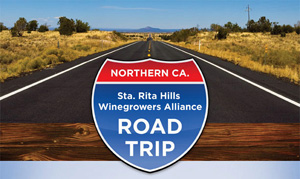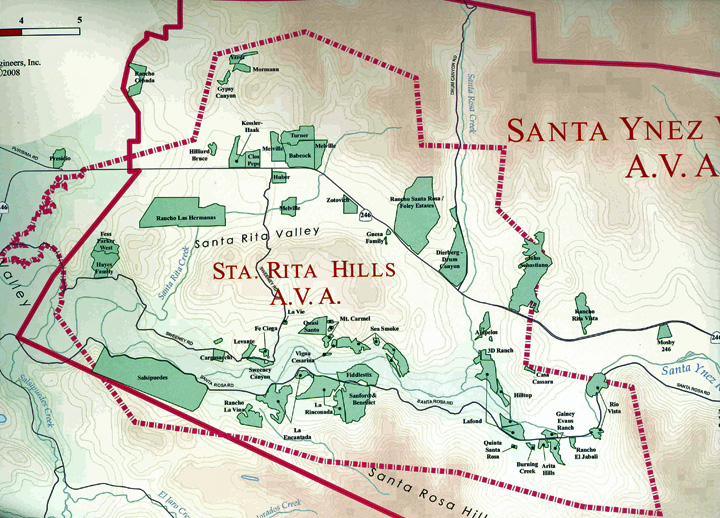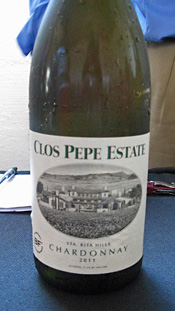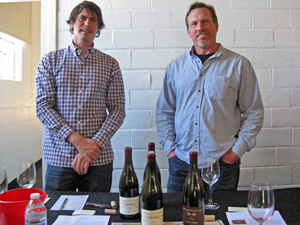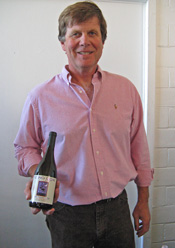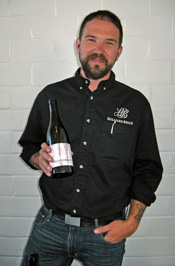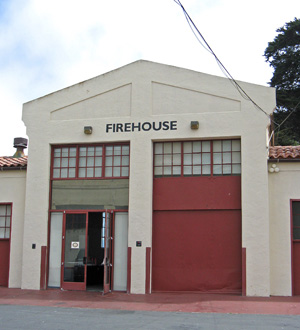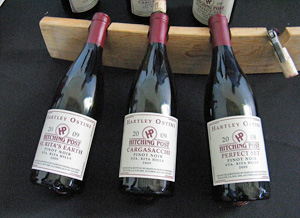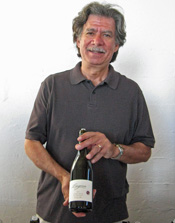Cargasacchi Wines
Point Concepción 2010 Pinot Grigio, “Celestina,” Santa Barbara County. Sourced from Sierra Madre Vineyard, whole-cluster pressed with very little skin contact. Light straw color, with aromas of ripe pear, spice, and a slight floral note. Medium weight on the palate with a smooth, pleasant finish.
Cargasacchi 2009 Pinot Noir, Cargasacchi Vineyard, Sta. Rita Hills. 100% Clone 115. Medium-light ruby color, displaying raspberry and black cherry fruit, earth, and dried herbs on the nose. Medium-bodied with good structure and a moderately grippy tannic finish.
Cargasacchi 2010 Pinot Noir, Cargasacchi-Jalama Vineyard, Santa Barbara County. From a 375ml bottle. Slightly darker color than the previous wine, this showed cherry, spice, a touch of black pepper, and a minerally note. Brighter acidity in the mouth with a fine texture and more refined tannins, nice.
Point Concepción 2005 Syrah, “Encantado,” Paso Robles. Blended with a little Viognier. Medium-dark purple, savory and spicy dark fruit along with hints of flowers and sweet oak. Big and rich, this still had substantial tannins on the finish.
Cargasacchi 2009 Pinot Grigio, “Invincible Sun,” Cargasacchi-Jalama Vineyard, Santa Barbara County. Fruit picked at 42 brix, residual sugar 14.5%, alcohol 16.3%. Medium-light gold color, with intense stone fruit, orangepeel, honey, and floral aromas. Lively acidity balanced the sweetness and the moderately rich mouthfeel, leading to a long, tasty finish, nice.
Comments: Peter Cargasacchi arrived a bit late, but poured a good group of wines. Most of them were sourced from fruit grown outside the Sta. Rita Hills – that’s Peter, breaking the rules as always! The 2010 Pinot Grigio differed from earlier versions in that this one had almost no skin contact so it did not have the pale pink color of previous vintages.
Clos Pepe Estate
Clos Pepe 2011 Chardonnay, “Barrel-Fermented,” Estate, Sta. Rita Hills. Fermented in about 5% new and 95% neutral French oak. Medium-light straw color, with bright apple and lemonpeel, spice, and a floral note, along with a touch of vanilla/oak. Medium-bodied and lively on the palate, with a long finish, nice.
Clos Pepe 2009 Pinot Noir, Estate, Sta. Rita Hills. Medium-light color, this showed earthy raspberry and black cherry fruit aromas along with dried herbs and baking spices. Medium weight in the mouth with good structure and moderate tannins.
Clos Pepe 2010 Pinot Noir, Estate, Sta. Rita Hills. Aged in about 20% new oak. Medium-light ruby color, more fruit-forward than the 2009, with ripe plum and darker fruit, lots of spice, and earth on the nose. Richer mouthfeel than the 2009 with firm balancing acidity and a grippier tannic finish.
Comments: The 2011 “Barrel-Fermented” Chardonnay is the first vintage of that wine that used any new oak, though it was a small percentage. The estate vineyard is just north of Highway 246, one of the westernmost vineyards located near that road.
Cold Heaven Cellars
Cold Heaven 2010 Viognier, Sanford and Benedict Vineyard, Sta. Rita Hills. Pale yellow-straw color, with citrus and lemonpeel aromas, plus a stony mineral note. Medium-bodied with a slightly creamy texture, bright acidity, and a long, crisp finish, nice.
Cold Heaven 2011 Viognier, Sanford and Benedict Vineyard, Sta. Rita Hills. Similar color to the 2010 displaying more intense and ripe fruit on the nose, with more of a stone fruit profile and a hint of flowers. A bit bigger on the palate than the 2010 but retaining plenty of acidity and a lively finish.
Cold Heaven 2010 Pinot Noir, “Makepeace,” Santa Barbara County. Medium color, this showed herb and earth upfront, along with black cherry and plum, and undertones of vanilla/oak. Medium-bodied with a fairly smooth texture and milder tannins.
Cold Heaven 2010 Pinot Noir, “Nevertell,” Sta. Rita Hills. Medium ruby color, featuring riper and somewhat higher-toned plum fruit, plus spice and vanilla/oak notes. Bigger and richer in the mouth, with moderate tannins on the finish.
Comments: Peter Cargasacchi poured the Cold Heaven wines. I had tasted some of these early in the year during a visit with Cold Heaven’s Morgan Clendenen at her winery in Buellton. Her Viogniers continue to be some of California’s finest cool-climate renditions of that variety.
Dragonette Cellars
Dragonette 2012 Rosé, Happy Canyon of Santa Barbara. From 75% Grenache, 20% Mourvèdre, and 5% Syrah, whole-cluster pressed and aged in neutral barrels. Light salmon-pink color, with bright red fruit, fresh herbs, and earth aromas. Medium-light weight with a fairly smooth texture and crisp finish.
Dragonette 2012 Sauvignon Blanc, Happy Canyon of Santa Barbara. Sourced from 60% Grassini Vineyard and 40% Vogelzang Vineyard, made in 75% stainless steel and 25% neutral oak. Light straw color, showing bright lemon and grapefruit aromas with grassy/herbal overtones. Moderately light weight on the palate with a lively mouthfeel and finish.
Dragonette 2011 Pinot Noir, Sta. Rita Hills. Sourced from seven vineyards, mostly from Hilliard Bruce and John Sebastiano, aged in barrel for 15 months. Medium ruby color, this displayed darker berry fruit, spice, stony minerals, earth, and a touch of sweet oak. Medium-bodied with good structure and moderate tannins, nice.
Dragonette 2011 Pinot Noir, Fiddlestix Vineyard, Sta. Rita Hills. From 113, 115, 667, and 777 clones, aged for 18 months in 25% new oak. Medium-dark color, showing more of a red-fruit profile than the previous wine, along with more earth and vanilla/oak elements. More weight on the palate with a grippier finish.
Comments: Two of Dragonette’s three proprietors, John Dragonette and Brandon Sparks-Gillis, were behind the table pouring their wines – John’s brother Steve is the third. The winery was founded in 2004 and the wines are made in Lompoc.
Fiddlehead Cellars
Fiddlehead 2012 Pinot Noir Rosé, “Pink Fiddle,” Sta. Rita Hills. Picked early, destemmed, and pressed after 36 hours of skin contact. Very light pink color, featuring bright and fresh strawberry fruit, earth, and hints of flowers and herbs. Lighter-bodied with refreshing acidity and a very mild bite of tannin on the tasty finish, nice.
Fiddlehead 2009 Pinot Noir, “Seven Twenty Eight,” Fiddlestix Vineyard, Sta. Rita Hills. Medium-light garnet color, this had ripe red fruits, earth, spice, and vanilla/oak on the nose. Medium weight on the palate with moderate tannic grip on the finish.
Comments: Kathy Joseph’s Fiddlehead Cellars specializes in Sauvignon Blanc and Pinot Noir – the Pinot comes from their estate Fiddlestix Vineyard, which also supplies fruit to many other producers. The “Pink Fiddle” was one of the best Pinot-based Rosés I’ve tasted lately, and should be a very good summertime wine.
Flying Goat Cellars
Flying Goat 2009 Pinot Noir, Rancho Santa Rosa, Sta. Rita Hills. All 667 clone. Medium-light color, displaying bright and savory darker fruits, along with spice and vanilla/oak notes. Medium-bodied with fairly mild tannins.
Flying Goat 2009 Pinot Noir, “Clone 2A,” Rio Vista Vineyard, Sta. Rita Hills. Medium-light color, showing riper red fruits, earth, and baking spices on the nose. Medium weight with a bit more structure and tannin than the previous wine.
Flying Goat 2009 Pinot Noir, “Dijon,” Rio Vista Vineyard, Sta. Rita Hills. From about 70% 667 clone and 15% each 115 and 777 clones. Slightly darker color, with a stony/minerally quality along with spice, darker berry fruit, dried herbs, and black pepper aromas. A bit richer mouthfeel than the first two wines with good balancing acidity and refined tannins on the finish, nice.
Comments: Flying Goat owner/winemaker Norm Yost was behind the table to pour his wines. Norm launched Flying Goat in 2000. In addition to Pinot Noir, Norm also makes several sparkling wines under his Goat Bubbles label.
Hilliard Bruce Vineyards
Hilliard Bruce 2010 Pinot Noir, “Sun,” Sta. Rita Hills. Sourced from all Pinot blocks of the estate vineyard. Medium-light ruby color, aromas of forest floor, minerals, and spice upfront with bright red fruits and a slight floral note in support. Very lively mouthfeel with a silky texture and refined tannins, nice.
Hilliard Bruce 2010 Pinot Noir, “Moon,” Sta. Rita Hills. Barrel selection. Slightly darker color, this featured more vanilla/oak and spice along with a darker fruit profile, plus earth and dried herb notes. Bigger-bodied with plenty of structure and a grippier tannic finish.
Comments: Hilliard Bruce general manager Robert Wyngard poured the wines at the tasting. Fruit is sourced entirely from the 21-acre estate vineyard – 18½ acres of Pinot and 2½ acres of Chardonnay, planted 2004-2007. Clones include 76 and 96 for Chardonnay, and Pommard, Calera, 667, and 777 for Pinot (some 828 was recently grafted to Chard). Paul Lato was the consulting winemaker and made the 2010 wines, with owner John Hilliard taking over the winemaking the past couple of vintages.
|
Hitching Post Wines
Hitching Post 2009 Pinot Noir, “St. Rita’s Earth,” Sta. Rita Hills. Fruit sourced from Fiddlestix and Rio Vista vineyards. Medium-light color, showing ripe red fruits and hints of earth, wet stone/minerals, and sweet oak. Medium-bodied with good structure and a moderately chalky finish, nice.
Hitching Post 2002 Pinot Noir, Fiddlestix Vineyard, Santa Rita Hills. Medium-light garnet color, with a little bricking around the edges, this displayed red fruits and a big savory component, plus earth and spice notes. Still retaining good acidity, with a lively mouthfeel and well-resolved tannins, nice example of an older Fiddlestix Pinot.
Hitching Post 2009 Pinot Noir, Cargasacchi Vineyard, Sta. Rita Hills. Medium ruby color, with ripe dark berry fruit, spice, and vanilla/oak. Medium weight on the palate with plenty of structure, and a grippier tannic finish.
Hitching Post 2009 Pinot Noir, “Perfect Set,” Sta. Rita Hills. Sourced entirely from Fiddlestix Vineyard, aged in 70% new oak. Medium color, featuring lots of spice on the nose, a bigger vanilla/oak element, plus raspberry and black cherry fruit and earth. Richer mouthfeel with firm tannins, this still needs time to develop.
Comments: Hitching Post co-owner Gray Hartley was on hand to pour his wines. The “St. Rita’s Earth” Pinot was a good example of blending fruit from both the warmer and cooler sides of the Sta. Rita Hills. The “Perfect Set” bottling is only produced in better vintages. Gray poured a library wine in addition to current releases – the 2002 Pinot was labeled “Santa Rita Hills,” pre-dating the current designation for the AVA as “Sta. Rita Hills.”
Kessler-Haak Vineyard and Wines
Kessler-Haak 2011 Dry Riesling, Lafond Vineyard, Sta. Rita Hills. From 40-year old vines, made in stainless steel. Very light color, with apple and pear fruit plus distinct petrol notes. Bright and a bit minerally on the palate with a crisp finish, nice.
Kessler-Haak 2010 Chardonnay, Estate, Sta. Rita Hills. Made in about 35% new oak. Light straw color, this showed citrus and apple, spice, and vanilla/oak on the nose. Medium-bodied with a moderately creamy texture and finish.
Kessler-Haak 2010 Pinot Noir, “Clone 2A,” Estate, Sta. Rita Hills. Aged in neutral oak. Medium ruby color, this had floral black cherry aromas, with notes of fresh herbs and iron/mineral. Medium weight in the mouth with refined tannins and a long finish, nice.
Kessler-Haak 2009 Pinot Noir, Estate, Sta. Rita Hills. From Pommard, 115, 667, and 777 clones, aged in neutral oak. Slightly lighter color, featuring raspberry and red cherry fruit and herbs. Lively mouthfeel with a moderately tannic finish.
Kessler-Haak 2010 Pinot Noir, Estate, Sta. Rita Hills. Aged in 30% new oak. Medium color, this displayed more vanilla/oak on the nose along with darker fruit and spice. Bigger structure on the palate with a grippier finish.
Kessler-Haak 2010 Pinot Noir, “Pommard Clone,” Estate, Sta. Rita Hills. Aged in 50% new oak. Slightly darker color, this had more savory aromas along with flowers and forest floor notes, with darker fruits, black pepper, and spice in supporting roles and a hint of sweet oak in the background. A more muscular style with a structured mouthfeel and bigger but not aggressive tannins, nice.
Kessler-Haak 2010 Syrah, Lafond Vineyard, Sta. Rita Hills. Aged in 50% new oak. Medium-dark purple, with plum and blueberry fruit, herbs, mocha, and black pepper aromas. Medium-full bodied with fairly grippy tannins, this needs time to develop.
Comments: Grower/winemaker Dan Kessler was behind the table to pour his wines. The estate vineyard is adjacent to Clos Pepe and includes 27 acres of Pinot Noir and 3 acres of Chardonnay. All of the Pinot fruit is destemmed prior to fermentation. The first Kessler-Haak wines from estate fruit were from the 2009 vintage. This was a strong line-up of wines.
Lindley Wines
Lindley 2011 Pinot Noir, La Lomita Vineyard, Sta. Rita Hills. Aged in about 20% new oak. Medium ruby color, with upfront black cherry and plum fruit, spice, and a touch of oak on the nose. Medium weight on the palate with a smooth mouthfeel and mild tannins.
Comments: Jake Lindley poured his wine at the tasting. La Lomita is a small vineyard near the eastern boundary of Sta. Rita Hills. Jake planted an estate vineyard in 2011, and he’s expecting to have the first harvest of Chardonnay and Pinot Noir from there this fall.
Liquid Farm
Liquid Farm 2012 Rosé, Vogelzang Vineyard, Happy Canyon of Santa Barbara. From 95% Mourvèdre and 5% Grenache. Light salmon color with mild strawberry, herb, and earth aromas. Medium-light bodied with moderate acidity and a slightly chalky finish.
Liquid Farm 2011 Chardonnay, “White Hill,” Sta. Rita Hills. From Bentrock, Zotovich, Huber, Clos Pepe, Kessler-Haak, Rita’s Crown, and Radian vineyards, aged in neutral oak. Medium-light straw color, with citrus and green apple, herb, earth, and a slight minerally note on the nose. Medium texture in the mouth with juicy acidity and a crisp finish, nice.
Liquid Farm 2011 Chardonnay, “Golden Slope,” Sta. Rita Hills. From 72% Rita’s Crown, 17% Clos Pepe, and 11% Zotovich vineyards, aged in 18% new oak. Medium-light straw color, this showed more vanilla/oak and spice, along with pear and stone fruit. Richer mouthfeel and finish than the “White Hill.”
Liquid Farm 2011 Chardonnay, “Four,” Sta. Rita Hills. From 75% Clos Pepe and 25% Rita’s Crown vineyards, aged in 25% new oak. Medium-light color, this featured apple and citrus aromas along with fresh herbs and nicely-integrated oak. Moderately creamy on the palate but with good balancing acidity and a lively finish, nice.
Comments: Liquid Farm is the project of Jeff and Nikki Nelson, and the winery specializes in Chardonnay. Brandon Sparks-Gillis of Dragonette has made the wines there. The “White Hill” bottling is described as Chablis-style, while Meursault is the inspiration for the “Golden Slope.” The “Four” is a tribute to their first wine – four barrels of 2009 Chardonnay.
Richard Longoria Wines
Longoria 2011 Chardonnay, “Cuvée Diana,” Sta. Rita Hills. Named for Rick’s wife, the fruit was sourced from four vineyards, mostly from Rita’s Crown and Rancho Santa Rosa, and fermented and aged in about 30% new oak. Light straw color, with apple, spice, and orangepeel aromas along with a touch of vanilla/oak. Medium-light bodied with a lively texture and finish, nice.
Longoria 2011 Pinot Noir, “Lovely Rita,” Sta. Rita Hills. Entirely sourced from Fe Ciega Vineyard fruit. Medium ruby color, this showed black cherry, spice, tea leaf, and a slight stony/mineral note. Bright mouthfeel with medium-light tannins, a good value.
Longoria 2009 Pinot Noir, Fe Ciega Vineyard Sta. Rita Hills. From Pommard, 115, 667, and Mount Eden clones, aged in 30% new oak. Slightly darker color, this was less fruit-forward, with minerally and earthy plum and darker berry fruit, along with herbs and black pepper. Medium-bodied with a richer mouthfeel and more structure than the previous wine, finishing with moderate tannins, quite nice now and should age well.
Longoria 2010 Pinot Noir, Fe Ciega Vineyard Sta. Rita Hills. Aged in about 28% new oak. Medium-dark color, with a darker fruit profile and a more noticeable mineral component along with savory and vanilla/oak aromas. Fairly big and structured on the palate, with grippier tannins than the 2009 vintage, this could be very good with more time in the cellar.
Comments: Rick Longoria was on hand at the tasting to pour his wines. All the Pinots are made with 100% destemmed fruit. Rick founded the Longoria label in 1982, and he’s considered one of Santa Barbara County’s true pioneer winemakers. In 1998, he established the first winery in what’s now known as the Lompoc Wine Ghetto. The estate Fe Ciega Vineyard is sited on a mesa high above the Santa Ynez River, and is planted to mostly Pinot Noir along with a little Chardonnay.
Pali Wine Company
Pali 2011 Pinot Noir, “Summit,” Sta. Rita Hills. Multi-vineyard blend, including fruit from Rancho La Viña, Bentrock and Radian vineyards. Medium ruby color, with ripe dark fruit, earth, spice, and a slight floral note. Medium-bodied with milder tannins. Ready to drink now, and a good value.
Pali 2011 Pinot Noir, Cargasacchi Vineyard, Sta. Rita Hills. Entirely from 115 clone. Medium color, this featured black cherry, earth, fresh herbs, and a touch of black pepper on the nose. Good structure and fine tannins, nice.
Pali 2011 Pinot Noir, Fiddlestix Vineyard, Sta. Rita Hills. From Pommard, 115, 667, and 777 clones. Medium color, showing somewhat higher-toned red fruits and more spice. Medium-weight on the palate with moderate tannins.
Pali 2011 Pinot Noir, Rancho La Viña, Sta. Rita Hills. Slightly darker color, riper fruit and more vanilla/oak and spice aromas. Richer texture with more grip on the finish.
Comments: The Pali label was launched in 2005 by Tim Perr and Scott Knight. Consulting winemaker Kenneth Juhasz and winemaker Aaron Walker produce the wines at Pali’s winery in Lompoc. Aaron poured the wines at the tasting – the 2011 single-vineyard Pinots I tasted have not yet been released. Pali is starting to farm vineyards in the Sta. Rita Hills and Sonoma County, and they’ve recently worked out a long-term lease of Huber Vineyard, near Clos Pepe.
Siduri Wines
Siduri 2011 Pinot Noir, Sta. Rita Hills. From 41% Clos Pepe, 35% Cargasacchi, and 24% John Sebastiano vineyards. Medium color, this displayed earthly black cherry fruit and spice. Medium-light bodied, with a slightly minerally mouthfeel and moderate tannins.
Siduri 2011 Pinot Noir, Clos Pepe Vineyard, Sta. Rita Hills. From Pommard and 115 clones, some whole-cluster fermentation. Slightly darker color, with a darker ripe fruit profile plus significant herb and baking spice components and a touch of sweet oak. Medium weight on the palate with good structure and refined tannins on the finish, nice.
Comments: Siduri was the lone non-Santa Barbara County winery to pour at the tasting. They have made Pinots from Sta. Rita Hills fruit for many years. Anthony Silvas was behind the table, and he mentioned that the 2011 Sta. Rita Hills appellation bottling includes all of the 2011 fruit that Siduri got from both Cargasacchi and John Sebastiano Vineyards that year (no Cargasacchi vineyard-designate in 2011), as well as 70% of the Clos Pepe fruit.
Zotovich Cellars
Zotovich 2012 Viognier, Estate, Sta. Rita Hills. Very light yellow, with tropical fruit, peach, and slight floral and banana notes on the nose. Medium-light bodied with bright acidity and a lively finish, nice.
Zotovich 2010 Chardonnay, Estate, Sta. Rita Hills. From clone 76, made in 40% new French oak. Light straw color, this had vanilla/oak aromas plus apply fruit and spice. Medium-light bodied with a crisp finish.
Zotovich 2010 Pinot Noir, Estate, Sta. Rita Hills. From 113, 114, 115, and 777 clones, aged in 40% new oak. Medium-light garnet color, showing bright cherry, earth, spice, and smoky oak. Medium weight on the palate with a moderately tannic finish.
Zotovich 2010 Syrah, Estate, Sta. Rita Hills. From clone 1, aged in about 35% new oak. Medium purple color, this had savory and herbal aromatics along with black fruits and vanilla/oak. Lively mouthfeel with fairly grippy tannins. Still very young and could be quite nice with some time in the cellar.
Comments: Winemaker Ryan Zotovich and assistant winemaker Dan Schuler-Jones were on hand to pour their wines. Ryan and his uncle Steve launched the Zotovich label in 2006. The estate Zotovich Family Vineyard is located just off Highway 246. Their Viognier was one of the few I’ve had that combined the intense aromatics of the riper style and the crisp acidity of the leaner style in the same package.
|


